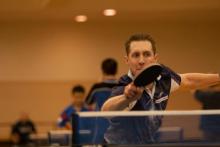Change-Up
Written by Coach Rich Burnside
What makes the change-up such an effective pitch in baseball? Trevor Hoffman made a career out of this very pitch. A good change-up is deceptive in nature. The batter expects a faster pitch and a different ball trajectory. This adds unpredictability to the pitch. The batter consequently must now anticipate both the change-up and fastball, thus making the fastball better as well. In our sport changing speeds can have a powerful effect when used properly to keep our opponents off balance. Here are a few specific ways we can accomplish this in our shot selection.
1) Timing of impact. This is when we catch the ball after the bounce. We can catch it quickly or later. Pushes can be very difficult to handle if they are caught very shortly after the bounce. This reduces the reaction time of our opponent. We can also wait on the ball especially if it is long. Changing this aspect of our shots can really bother a player who is used to drills at a consistent speed. In a match how many times have you seen a player fluff a ball up only to be missed because it was not expected. Catching the ball later takes some practice and patience. Concentrate when you actually strike the ball in relation to its flight (especially height).
2) Varying Spin. How solidly we contact the ball changes the pace as well, generally spin is inversely proportional to speed. Grazing the ball more will slow it down a bit and the differing spin will be difficult to deal with as well. Our racket angle is especially important here.. The throw angle will change depending on how open we have our bat. Adopting a side-spin approach will also slow down our shot to a certain extent. No-spin or slow-spin loops are like carrying the ball over the net and can be very deceptive. Experiment with how solid you contact the ball. Try wrist flicks and very slight grazes of the ball.
3) Junk. Twiddling with different rubber types, mostly slower ones can produce a drastic confusion effect for your friends. One of our club coaches Mark Fryberger was experimenting with shakehands; flipping the racket on each shot with multi-ball. It was awkward at first but he gradually learned to flip and adjust before every ball. Exercises like this can be very effective for changing the whole way the table tennis world sees junk rubber. The junk rubber player these days must think outside the box.
4) Service Speed. This seems so obvious but sometimes it is overlooked. If you are a player who loves fast counters why would you serve a short ball. Serving fast and long can be good for solid counter-ralliers, but if you do it every time eventually you will get burned. Changing up your service speed is very effective in keeping your opponent off-balance. Remember to serve with your junk once a match to see how she reacts to it. Sometimes the simplest serves are game changers.
Changing speeds can even up the scales when playing someone who is seemingly trying to overpower you. Experiment when drilling with these four principles and it will add depth to your game. Focus on when you are contacting the ball and how hard you are hitting it. Try a few change-ups to spice your game up. Trevor Hoffman will make the Hall of Fame because of it, maybe it can add a few hundred rating points to your game!





